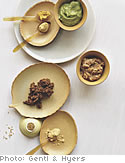More on Mustard

Strange as it may seem, one of the country's leading authorities on mustard is the former assistant attorney general for the state of Wisconsin. Barry Levenson, curator of the Mount Horeb Mustard Museum, helps us sort through the mustards in Paula Disbrowe's recipes:
Where To Buy America's Second-Most-Popular Condiment
- Dijon is made in or around Dijon, France, or according to the traditions of Dijon—meaning brown (sharper tasting) seeds as opposed to yellow.
- American yellow is generally mild and creamy and gets its color from turmeric.
- Grainy, whole grain, and old-fashioned mustards are coarse and use the entire seed, either crushed or left whole.
- Tarragon has a Dijon base flavored with the fresh herb (French style) or a yellow base with honey or sugar and just a touch of tarragon (American style).
- Honey mustard refers to most sweet mustards (some containing little or no honey).
- Provençale is a rare Dijon mustard flavored with sweet red peppers, tomatoes, and herbs from Provence.
Where To Buy America's Second-Most-Popular Condiment
- Mustardmuseum.com: In addition to the more than 4,000 varieties on display, the Mount Horeb Mustard Museum sells about 500 jars, bottles, and tubes through its Web site and catalog.
- Chefshop.com: Features about 20 domestic and European specialty mustards.
- Stonewallkitchen.com: Stonewall's 12 mustards (try the wasabi or margarita) are made using seeds ground at the country's oldest mustard mill, in Eastport, Maine.
- Maille.com: Well known for its fiery Dijon, Maille has a new U.S. Web site. No online orders, unfortunately, but you can request a mail-order catalog.



